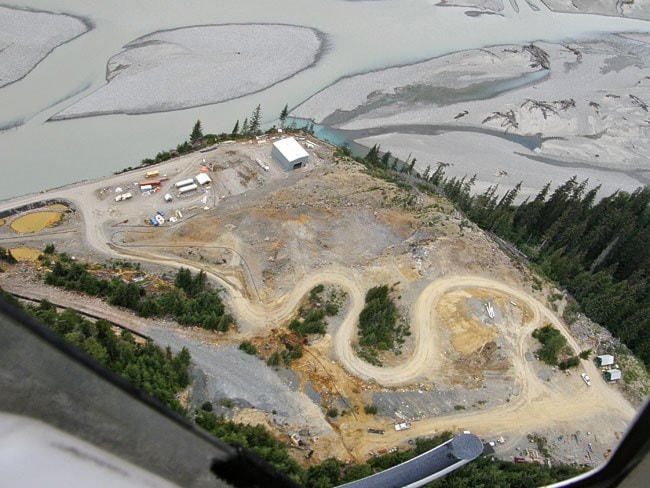Plans to build a mine from the tailings left at the Tulsequah Chief mine near Atlin B.C., have been pushed back once again.
Chieftain Metal Inc.‘s plans depend on building a road to the mine site.
Its predecessor, Redfern Ventures, received the province’s approval to build that road. Chieftain inherited this after Redfern went bankrupt.
But in April, the company applied to change the road’s route.
The new 122-kilometre road would still run from the mine site to the lower Nakonake River. From there, it would branch off the approved route to a junction with Atlin’s Warm Bay Road.
This would mean fewer stream crossings and possibly some cost savings for the company, which says it changed the route to respect the wishes of the Taku River Tlingit First Nation.
So far, the First Nation has remained mum about the road.
Originally, it agreed to offer a position on the road by June. But now the First Nation is waiting to see if the province approves the new route before they take a stand.
The province is also waiting.
The road cannot be permitted until it gets the go-ahead by the environmental assessment office, said Vivian Thomas, a communications manager with the Ministry of Forests, Lands and Natural Resource Operations.
And the environmental assessment office has more questions for the company.
The assessment office wants more details from Chieftain about wildlife impacts and mitigation, said Trish Rorison, a public affairs official with the province’s Ministry of Environment. That information is expected by June 8.
Once the application is submitted, it can take more than six months, according to the government’s website.
Technically, Chieftain is able to start building the first part of the road. But that would require doing so without the First Nation’s approval.
The two parties signed a letter of understanding in May 2011. But the Taku River Tlingit are still trying to finalize an agreement with the company.
“There is serious concern for the TRTFN, that several months of negotiations have failed to move this file forward in any substantial way,” the First Nation’s website says of the impacts, mitigation and mutual benefits agreement.
The new road route does avoid the Nakina Trail, which the First Nation is determined to protect, but it does still come within 1.2 kilometres of the trail, at its nearest point, according to the First Nation’s official status of the project, posted on its website.
The question “is it really worth it” needs to be asked, said Chris Zimmer of the Alaska-based Rivers Without Borders. The group has followed the development of this mine because the Taku River watershed crosses the border.
“We’re really seeing more opposition to the proposed Tulsequah Chief mine and road project and we’re seeing the company run into, I think, serious difficulties over the last couple months here related to permitting, financing and getting approval to their road route,” said Zimmer.
“There’s a host of risks and uncertainties. This is a relatively small mine with a relatively small deposit, but it’s taken up an incredible amount of people’s time and money and angst, and I think people are starting to really realize at this point that it really isn’t worth it.”
But even Zimmer admits that the community of Atlin is divided on the issue. Some welcome the jobs and money this project could bring with it, while others don’t want 14,220 hectares of Crown land torn up next door.
Chieftain asserts that its project would help clean up two old mine sites. The company has built a water treatment plant to address acid mine drainage from previous mine workings.
But that work has come in over budget, and the plant is producing more sludge than the company had originally planned to deal with.
The company also still needs to raise more than $300 million to build the mine, CEO Victor Wyprysky told the News in December, adding that the company was wooing global investors, specifically in Asian centres like Beijing and Hong Kong.
“I think folks should take a real critical look at this company,” said Zimmer. “It was formed out of bankruptcy when Redfern went bankrupt with the explicit purpose of purchasing this mine. The junior company never developed a mine and we have a history of just-missed deadlines and these overly optimistic predictions of when they’re going to get a permit.
“We have a history of really vague financial information, and we still don’t have a feasibility study.”
If that’s not enough, residents should also be aware of the slippery slope the proposed road to the mine presents, added Zimmer.
On May 10, Eagle Plains Resources announced its new Ringer project, which currently consists of 33,000 hectares of claims staked 80 kilometres south of Atlin.
The company listed four reasons for staking the new property. One was that the new road route being proposed by Chieftain crosses the Ringer Property.
“If you build it, they will come. Right?” asked Zimmer.
Contact Roxanne Stasyszyn at
roxannes@yukon-news.com
